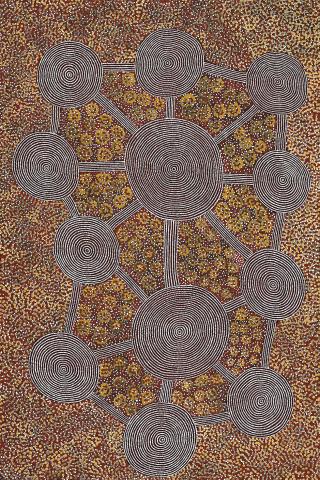THE TINGARI AT YAWALYURRU, 1990
ANATJARI TJAKAMARRA
synthetic polymer paint on canvas
182.0 x 121.5 cm
bears inscription verso: artist’s name, title, date, location and East to West exhibition cat. 96
Commissioned by Duncan Kentish in Docker River, Northern Territory, 1990
Collection of the late Duncan Kentish, Adelaide
East to West: Land in Papunya Tula Painting, Tandanya National Aboriginal Cultural Institute, Adelaide, 4 March – 3 June 1990, cat. 96
Kean, J., East to West: Land in Papunya Tula Painting, Aboriginal Cultural Institute, Adelaide, 1990, un-paginated, (Illus.)
Anatjari Tjakamarra's homeland is nestled in sandhill country, south west of Karrkurutinya (Lake Macdonald), country that is dominated by geological features associated with the actions of Kuninka, the Western Quoll (Dasyurus geoffroii).
Kuninka is a towering figure in the sacred epics of the Western Desert. His deeds are awe-inspiring, causing major landforms and inaugurating post-initiatory ceremonies coupled with the travelling Tingari ancestors.
The narrative celebrated in Tingari at Yawalyurru illustrates the dramatic interaction of Kuninka, with the Tingari Men, at one of the most significant sites in Pintupi country.1The events come into focus when Kuninka became aware that the Tingari had stolen from his country near Karrkurutinya, spearing and eating an emu without consent. Determined to exact his revenge, Kuninka followed the travelling Tingari, and at Mintjirnga, climbed a hill and made smoke to signal his presence. Kuninka then continued south to Yawalyurru, where he sighted a puff of smoke rising from a small hole in the earth, indicating the location of the subterranean camp of the Tingari Men. When they failed to respond to his calls, Kuninka thrust his throwing stick into the ground with explosive force 'like dynamite'.
Shaken, the Tingari climbed from the earth. Instead of seeing a host of men, they encountered Kuninka, sitting alone on the edge of a sandhill, remorseful for the havoc he had caused. Significantly, the Tingari left a trail of shiny, round deposits on the wall of their cave as they emerged. These dark forms became Yawalyurru, the tasty ‘black currant’ that gives its name to the place.
Kuninka then ordered the Tingari to leave the Yawalyurru and go to Kulkurta (the artist's birthplace). Kuninka's lust for revenge was finally sated when his sons destroyed the Tingari at Karrkurutinya with a deluge of hail and lightening.2
Anatjari has encoded the events at Yawalyurru within a constellation of interconnected concentric circles. The icon simultaneously represents the paths of Kuninka and the Tingari at Yawalyurru, and the body paint of the performers who re-enact these events in contemporary post-initiatory ceremonies.
An exemplary practitioner of the classical Tingari motif, Anatjari here features roundels composed of up to twenty-three perfectly executed concentric circles, whose precision and amplitude is intended to convey the authority with which Anatjari approaches his subject. The rigorous austerity of the Tingari design is softened by the lightness of dotted florets, hovering within a (ceremonial) space, delineated by the interconnected site-path motif – a pattern signifying the abundance of the bush fruit Yawalyurru, the growth of which is promoted by the performance of ceremony at this site.
The weightless, shimmering power of this canvas marks Tingari at Yawalyurru as a major work by Anatjari Tjakamarra, a founding master of the art of the Western Desert.
1. Kimber, D., ‘Anatjari Tjakamarra’, in Tjukurrtjanu: Origins of Western Desert Art, National Gallery of Victoria, Melbourne, 2011, p. 72
2. Myers, F., Pintupi Country, Pintupi Self: Place and Politics Among Western Desert Aborigines, Smithsonian Institution Press, Washington DC and Aboriginal Studies Press, Canberra, 1986, pp.62-64
JOHN KEAN
